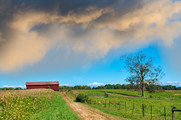|
Having trouble viewing this email? View it as a Web page.

|
|
|
Fresh From the Field is a weekly album showcasing transformative impacts made by partners supported by the National Institute of Food and Agriculture.
Editor: Falita Liles June 13, 2019
|
|
Success Stories

Growing with Compost May Protect Guam’s Water Supply
Guam relies heavily on its underground aquifer for water sources in the northern part of the island. At the University of Guam, Soil Scientist Dr. Mohammad Golabi wanted to find out whether the application of composted organic waste to crops would have any potential adverse effects on Guam’s underground aquifer.
“We have found that on the plots where compost was applied there was less nutrient/chemical leaching below the root zones, indicating that the chance of nitrogen and phosphate reaching the groundwater was slim. This planting method protects ground water from contamination by nitrates and phosphates which are provided by compost for plant growth,” said Golabi.
NIFA supports this research through Hatch and Multistate Research Funds.
Contact: Mohammad Golabi, University of Guam.
To read the article, visit the Western Pacific Tropical Research Center 2017 Impact Report.
|
News Coverage

Crop Signaling for Automated Weed/Crop Differentiation and Mechanized Weed Control in Vegetable Crops
Hand-weeding is an expensive component in vegetable weed management, but labor availability and costs are critically important factors for growers to remain profitable. Through this project, researchers are developing new weed control technologies to accurately detect, locate, and automatically kill weeds without damage to a crop.
The University of California – Davis team created machine vision technology to map weeds and identify crop plants. Research results show that this technology is very successful at detecting and distinguishing crop plants from weeds by using a foliar spray crop signaling system. This research is part of a collaborative effort with other states. The core technologies being developed through this joint effort may reduce hand-weeding costs by 25 percent, increasing efficiencies and profitability for growers.
NIFA supports the research through the Specialty Crop Research Initiative.
Learn more about this research at NIFA’s Data Gateway.
|
Library

University of Maryland Extension Engages Over 250,000 Marylanders
In 2018, University of Maryland Extension (UME) engaged over 250,000 Marylanders with its faculty, staff, 5,000 volunteers, and over 2,000 partnerships.
Another highlight of UME is the Master Gardener program. UME’s Master Gardener program, valued at $3 million, features 21 county/city Master Gardener coordinators, 2,000 volunteers, and 500 trainees. UME’s Home and Garden Information Center answered 6,300 garden and pest questions in 2018, making them the U.S. leader on Extension’s Ask an Expert platform.
Learn more at the 2018 UME Final Report.
|
Tweet of the Week
#NIFAIMPACTS

|
|

NIFA’s mission is to invest in and advance agricultural research, education, and extension that solve societal challenges. NIFA’s investments in transformative science directly support the long-term prosperity and global preeminence of U.S. agriculture. To learn more about NIFA’s impact on agricultural sciences, visit www.nifa.usda.gov/Impacts, sign up for email updates or follow us on Twitter @USDA_NIFA, #NIFAImpacts.
USDA is an equal opportunity lender, provider, and employer.
|
|